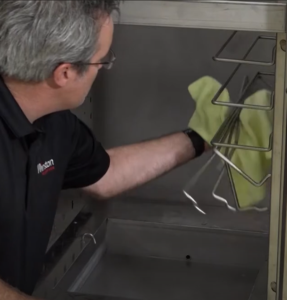Foie Gras Torchon [French for “fat liver tea towel”] is a specialty food made from the liver of a duck or goose. It’s a popular delicacy in French cuisine. Torchon refers to the tradition of wrapping the foie gras in a towel or cloth, poaching it, and letting it steep for a few days.
Recipes change a bit over time. Many chefs have dispensed with towels, and use plastic wrap instead.
The Recipe
- 1.2kg – Goose Liver
- 20g – Salt
- 5.8g – Sugar, granulated
- 2.9g – Prague Powder No. 1 (contains 6.25% sodium nitrate, 93.75% sodium chloride)
- 30g – Sauternes, or other dessert wine or cognac
The traditional recipe can be found on chefsteps.com.
Foie Gras Torchon Preparation
Typically, the liver will be purchased frozen. If so, allow it to slack in a refrigerator for three or four days. Slack the liver on the counter (wrapped) for 60 to 90 minutes or in a bowl of room-temperature water, for faster tempering. Much of the liver is fat, and it will be very firm at refrigerated temperatures. Tempering makes the liver more pliable and easier to work with.
Using a small knife or tweezers, remove any blood spots, veins or bits of connective tissue from the liver. The goal of foie gras is to be velvety smooth, so it’s important to remove as many “bits” as possible. Though, honestly, it will be difficult to remove them all. That’s okay. Try not to disturb the organ too much as you search.
Transfer the liver to a large piece of plastic wrap. Using your hands and a chef’s knife, shape the liver into a rough rectangle, so that it will be easier to roll. Sprinkle the liver with Sauternes, or another dessert wine or a nice cognac, if available.
Combine the salt, sugar, and Prague powder. Sprinkle the combined spices onto the liver.
A note about Prague Powder #1: The ingredients include: 6.25% sodium nitrite and 93.75% salt. It will add flavor, a nice pink cured color, and will extend the shelf life and food safety of your foie gras torchon. But use caution in measuring it and adjust the amount accordingly if the liver is larger or smaller than 1.2kg. A pink coloring (processing aid that does not have to be declared) has been added to the powder to make it easier to differentiate from salt or sugar.
Wrap It Up - Foie Gras Torchon Shaped
Gently form the foie into a rough cylinder, keeping it as even as possible, and then flatten the ends. Wrap the near edge of the plastic over the cylinder and tuck it in. Leave a few inches of plastic wrap free on either side. Tie one end of the plastic wrap off to assist you in shaping the cylinder. Roll the cylinder back and forth on the counter, gently kneading it, to get it into a more uniform cylinder. When satisfied that it is a good shape, and the contents are uniformly distributed, tie off the other end of the plastic. If needed, wrap the torchon in another sheet of plastic wrap. Tie that wrap’s ends as well. Using a toothpick or small, sharp knife, pop any visible air pockets.
In traditional cooking, the torchon would next be placed in a water bath or sous vide immersion cooker. But this is Winston, so we’re changing it up. Using a hook, hang the torchon in the CVap oven, so it’s hanging vertically. This will help avoid a flattening that often occurs when cooking horizontally.
Settings
Set CVap® Oven to 104°F vapor temp, in sous vide mode. Convection fan should be on. High yield should be off. In this case, we’re using an RTV7-05 oven.
Cook for 35 minutes.
Remove foie gras torchon from oven, and chill in refrigerator overnight. Ideally, it should hang in the refrigerator (as it did in the oven) to avoid flattening.
Serving
There is no need to remove the plastic wrap, just slice right through it (though remember to remove it from the slices). Always serve torchon cold. You will find that slicing with a warm knife makes for a smoother cut. Dipping the knife in warm water prior to slicing should suffice.
We served the torchon with crushed Biscoff biscuits, pickled mustard seeds and honey fig butter. It would also be quite delicious on toasted brioche (or any crusty bread of substance), with fresh figs, or any fruit preserves.
Final Thoughts
You may be thinking that 104°F is too low for poultry. That would be true of poultry muscle. But this is an organ that is made up of about 30% fat. Cooking any higher would result in a rendered mess. Since this item is cured, there’s less worry about food safety. It’s a time-tested recipe.
Recipe Recap
- 1.2kg Goose Liver
- 20g Salt
- 5.8g Sugar, granulated
- 2.9g Prague Powder No. 1 (contains 6.25% sodium nitrate, 93.75% sodium chloride)
- 30g Sauternes, or other dessert wine or cognac
The traditional recipe can be found on chefsteps.com.
Slack liver on counter (wrapped) for 60 to 90 minutes, or in a bowl of room-temperature water, for faster tempering.
Remove any blood spots, veins or bits of connective tissue.
Transfer liver to a large piece of plastic wrap. Shape the liver into a rough rectangle, so that it will be easier to roll. Sprinkle the liver with Sauternes, or another dessert wine, or cognac.
Combine the salt, sugar, and Prague powder. Sprinkle the combined spices onto the liver.
Gently form the foie into a rough cylinder, keeping it as even as possible. Flatten the ends. Wrap the near edge of the plastic over the cylinder and tuck it in. Leave a few inches of plastic wrap free on either side. Tie one end of the plastic wrap off to assist you in shaping the cylinder. Roll the cylinder back and forth on the counter, gently kneading it, to get it into a more uniform cylinder. When satisfied that it is a good shape, and the contents are uniformly distributed, tie off the other end of the plastic. If needed, wrap the torchon in another sheet of plastic wrap. Tie that wrap’s ends as well. Using a toothpick or small, sharp knife, pop any visible air pockets.
Using a hook, hang the torchon in the CVap oven, so it’s hanging vertically.
Program
CVap RTV7-05UV Retherm Oven as follows:
- 104°F Vapor Temp
- SV (Sous Vide) Air Temp
- Cook Time: 35 minutes
- Convection Fan: On
- High Yield: Off
Remove from oven, and chill in refrigerator overnight. Hang vertically in the refrigerator to avoid flattening.
Serving
There is no need to remove the plastic wrap, just slice right through it. Always serve torchon cold. Slicing with a warm knife makes for a smoother cut. Dipping the knife in warm water prior to slicing should suffice.
Serve with crushed Biscoff biscuits, pickled mustard seeds, and honey fig butter. It would also be delicious on toasted brioche, with fresh figs or fruit preserves.











